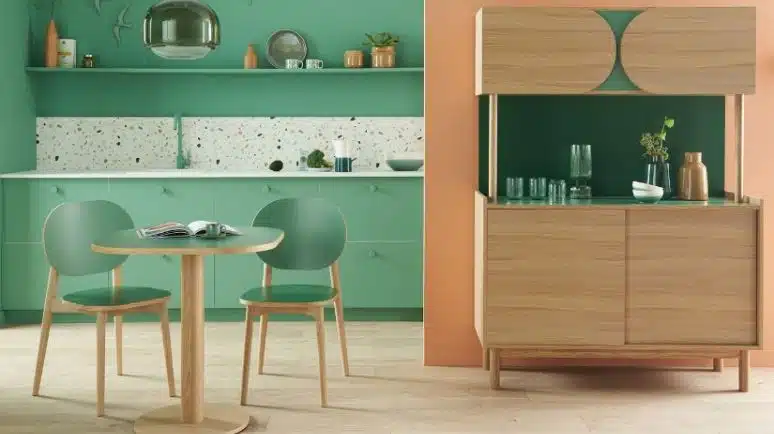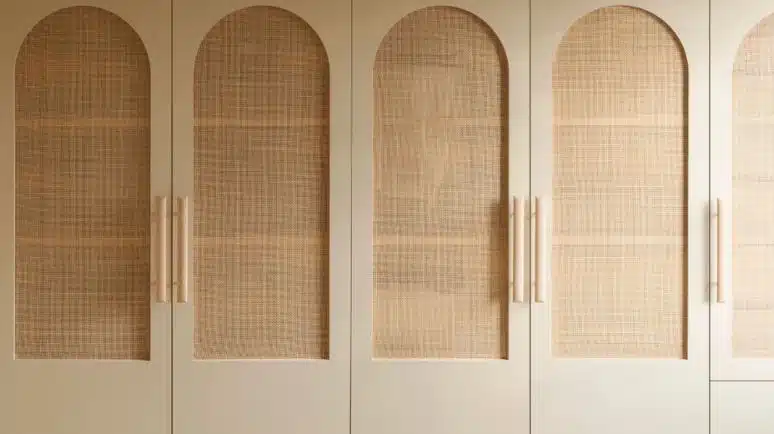
Modern Laminates: The Stylish, Budget-Friendly Upgrade Your Home Needs
November 14, 2024
Decorative Metal Laminate Sheets: The Secret to Modern, Luxe Interiors
December 6, 2024If you are in the middle of a home makeover or just looking to update your furniture, you have probably come across two materials that sound pretty similar: Veneer and Laminate. Although they both might seem like smart and affordable alternatives to solid wood or stone, they do have a fine line of difference between them. In this article, we will dive deep and compare veneer vs. laminate. So let’s get started!
Understanding Veneer & Laminates
Veneer and laminate are two popular surface materials used in furniture and interior design, but they differ significantly in composition and appearance.
Veneer:
Veneer is a thin slice of real wood or sometimes stone that’s bonded to a core material like MDF or plywood. It offers the authentic look and texture of natural wood, making it a luxurious choice for high-end furniture and cabinetry.
Laminate:
Laminate is a synthetic material made by layering paper or fabric soaked in resin and then bonding it to a substrate like MDF or particleboard. Laminate comes in a wide range of designs, from wood and stone effects to bold patterns, offering durability, low maintenance, and affordability.
When it comes to veneer sheets vs. laminates, veneer provides the warmth and beauty of natural materials, laminate gives you versatility, ease of upkeep, and a more budget-friendly alternative. Both materials offer unique benefits, depending on the desired aesthetic, durability, and cost.
Veneer vs. Laminate: Key Differences
Here’s a breakdown of the key differences between veneer and laminate:
Based on Material Composition:
- Veneer: Veneer is made from thin slices of real wood or sometimes stone, which are bonded to a substrate like plywood, MDF, or particleboard.
- Laminate: Laminate sheets, on the other hand, are a synthetic material created by layering paper or fabric soaked in resin and then bonding it to a core material, typically MDF or particleboard.
Based on Aesthetic Appeal:
- Veneer: Known for its natural beauty, veneer offers a rich, authentic appearance with real wood grain patterns. It exudes a luxurious, high-end feel that’s hard to replicate with synthetic materials.
- Laminate: While laminate can replicate the look of wood, stone, or even metal, it’s ultimately a printed design that doesn’t offer the same depth or authenticity as veneer.
For example, a wardrobe can be adorned with both veneer and laminate. However, when it comes to veneer vs. laminate wardrobe, a veneer wardrobe would exude a more luxurious feel than a laminate.
Based on Durability:
- Veneer: While durable, veneer is generally more susceptible to scratching, chipping, and moisture damage compared to laminate.
- Laminate: Laminate is known for its superior durability. It’s resistant to scratches, stains, and moisture, making it ideal for high-traffic areas like kitchens, bathrooms, and commercial spaces.
Based on Maintenance:
- Veneer: Veneer requires more care and maintenance than laminate.
- Laminate: Laminate is relatively low-maintenance. It’s easy to clean with regular wiping, and because it’s more resistant to moisture and stains, it’s easier to maintain over time.
Laminate vs. Veneer Price:
- Veneer: Typically more expensive than laminate due to the use of real wood or natural materials.
- Laminate: Laminate is more affordable, making it a popular choice for budget-conscious homeowners or large-scale commercial applications.
Based on Environmental Impact:
- Veneer: Veneer is considered more environmentally friendly than solid wood because it uses less wood to achieve the same aesthetic effect.
- Laminate: While laminate is made from synthetic materials, many modern laminates are produced with eco-friendly practices and contain recycled content.
Based on Application:
- Veneer: Best suited for luxury furniture, custom cabinetry, and high-end interiors where the authentic look and feel of real wood is desired.
- Laminate: Ideal for countertops, flooring, furniture, and wall panels. Laminate excels in high-traffic areas or environments where durability and easy maintenance are more important than the authentic appearance of natural materials.
Choosing between veneer and laminate depends on your priorities. If you’re looking for authenticity, luxury, and the natural beauty of real wood, veneer is the way to go. However, if you want durability, affordability, and low-maintenance surfaces, laminate is a practical and versatile option.




